Update: I also have a soy-free corn-free version of my homemade whole grain chicken feed! For easy formulating, download Garden Betty’s Chicken Feed Calculator to manage costs, calculate protein content, and custom mix your feed on the fly.
More than nine years ago, I started mixing my own soy-free, mostly organic, whole grain chicken feed, and it’s still the best feed I could possibly give my hens. (I’ve tried the entire lineup from the feed store.)
The decision to feed a whole grain diet—versus a commercially formulated diet—is a personal one based on what I believe is best for my hens. Luckily, it also turned out to be an economical decision and a benefit to my own diet.
Homemade chicken feed is not as expensive or complicated as you may have thought or been told.
My small flock of hens lays two dozen eggs a week on a DIY diet of whole grains and leafy greens. Their feathers are soft and shiny, their personalities as perky as ever… so I must be doing something right!
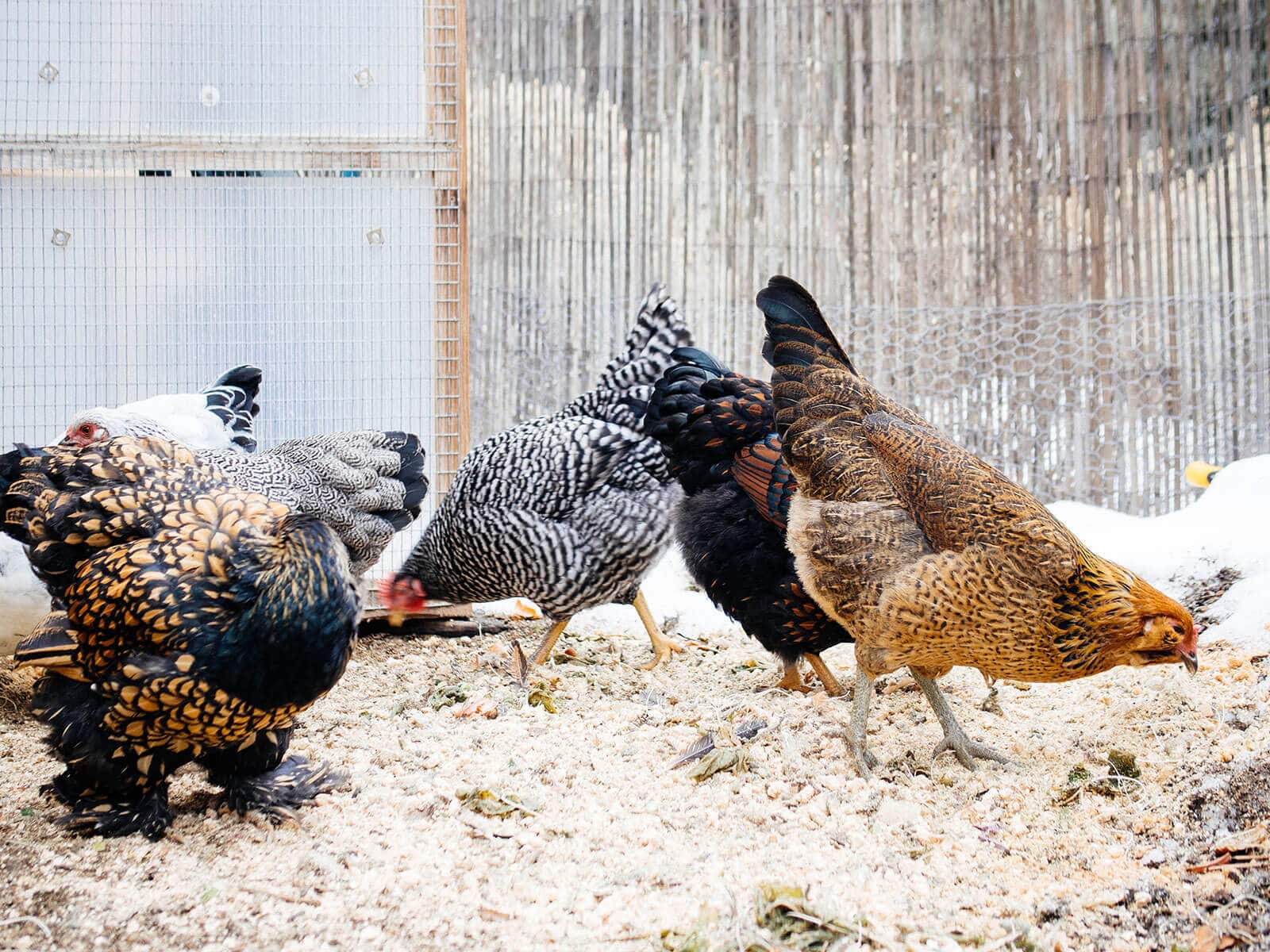
Why should you make your own whole grain chicken feed?
Commercial poultry feed comes in crumble or pellet form, neither of which looks like real food to me. Since real food comes out of my chickens, I want real food to go into them.
Crumbles and pellets are already formulated to contain the nutritional balance that a chicken needs, but the process of cracking, mashing, pressing and/or heating the grains (often times, not even quality grains) causes them to go stale and lose some of their nutritional value—even months before you buy them.
On the other hand, whole grains (which you can pick and choose) retain all of their nutrients.
With a whole grain diet, I’ve noticed that my hens eat less and poop less (as opposed to the crumble diet they started on). This leads me to believe that their bodies are processing the food better and it’s not just passing through them.
Disclosure: Garden Betty earns commissions on purchases made through these links to my affiliated retailers. View my policy.
Is a homemade whole grain diet a complete diet for a chicken?
Like humans, chickens need a diverse diet and sometimes they need a different diet in winter than they do in summer.
The greater variety of grains, legumes, and seeds you can provide your chickens, the healthier and happier they will be.
Layers need at least 16 percent protein and the rest is common sense—not too much fat, not too many carbs, and that last piece of chocolate cake is probably not a good idea. It’s all about balance.
I imagine that people wanting to make their own feed at home are likely also the sort of chicken keepers that let their chickens forage for bugs and weeds, or give their chickens mealworm treats and kitchen scraps. So overall, yes—this is a complete diet.
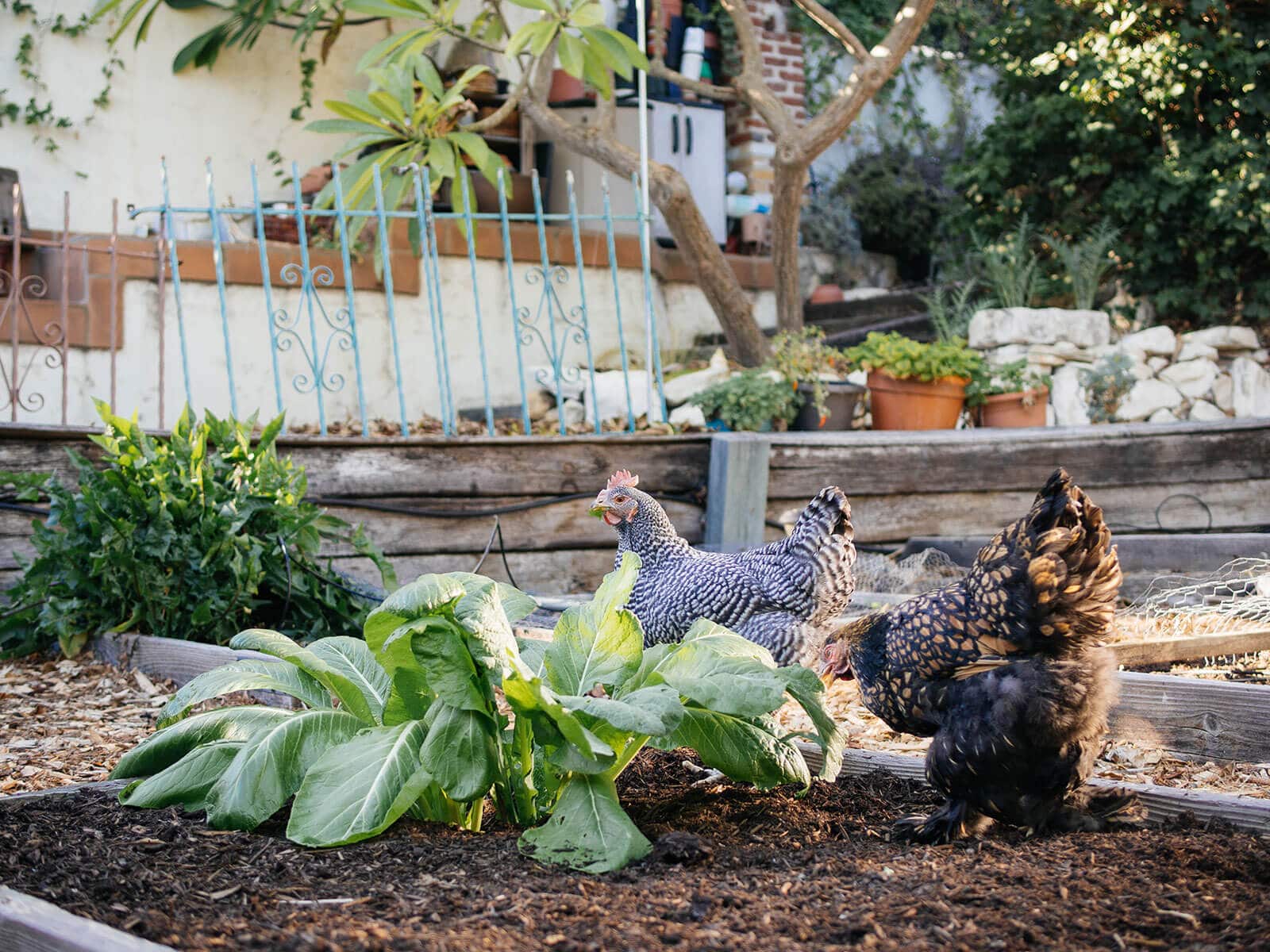
Why should chicken feed be soy-free and organic?
Because of its cheapness, availability, and high amount of protein, soy is a large part of a commercial chicken’s diet. But it’s also an incomplete protein, an unnatural source of food, and a highly processed food.
As with anything highly processed, soy has potentially harmful health effects ranging from vitamin deficiencies to hormone disruptions—especially when consumed in the crazy amounts that our culture does.
Soy is one of the most genetically-modified foods in the world, and it’s included in almost everything we eat. I know I can’t avoid it in my diet, but I can limit my intake of soy by choosing not to feed it to my chickens. You are what you eat.
(A pro-soy study found that soy protein transferred to the egg yolks and tissues of commercial chickens—even commercial “organic” chickens—fed a predominantly soy diet.)
An all-organic feed was originally not as important to me as a soy-free feed. I felt the benefits of a whole grain diet outweighed those of an organic (but processed) diet.
As it turned out, my homemade poultry feed is almost all organic, thanks to bulk purchases from Azure Standard and my local supermarket.

How much does DIY chicken feed cost?
My homemade chicken feed actually costs the same as the commercial poultry feed at my local feed store. This may not be true for everyone, but on the west coast, a premium bag of soy-free, organic layer pellets averages $0.70 per pound.
My soy-free, almost organic, whole grain feed costs $0.69 per pound (and would even be less if I purchased in larger bulk quantities—but I have a small flock and very limited storage).
This isn’t cheap chicken feed by any means, but it’s also not exorbitantly expensive considering the quality ingredients that go into it. You can lower the cost by going in with a fellow chicken-keeper on 50-pound bags of grains, or by using animal-grade ingredients instead of human-grade (which is what you’ll find in feed stores, and they’re perfectly acceptable).
An unexpected advantage of mixing my own feed is that I can share a lot of the grains, legumes, and seeds with my chickens, and I even use some of the same grains in my homemade dog food.
The ingredients are all human grade and mostly organic, and the fact that they can feed the whole household makes buying 10- or 25-pound bags of grains more feasible.
While there was a lot of legwork in the beginning to make my own recipe, the payoff is learning more about nutrition than I ever thought I would and knowing what goes into my chickens’ food (and ultimately, what goes into me).
I mix a new batch of feed two or three times a month. It feels like garden therapy. I have a strange love for running my hands through a mountain of whole grains.
It’s not any more work than refilling the feeder with bagged feed, and I have the option of changing up the mix every once in a while, rather than being stuck with the same 50-pound bag of commercial feed.
(This is advantageous if you have a mixed flock of chicks, pullets, and/or layers with varying protein needs, or want to alter their diet in winter or summer. I cover the nutritional needs of different age groups in my post that helps you calculate protein for your own chicken feed.)
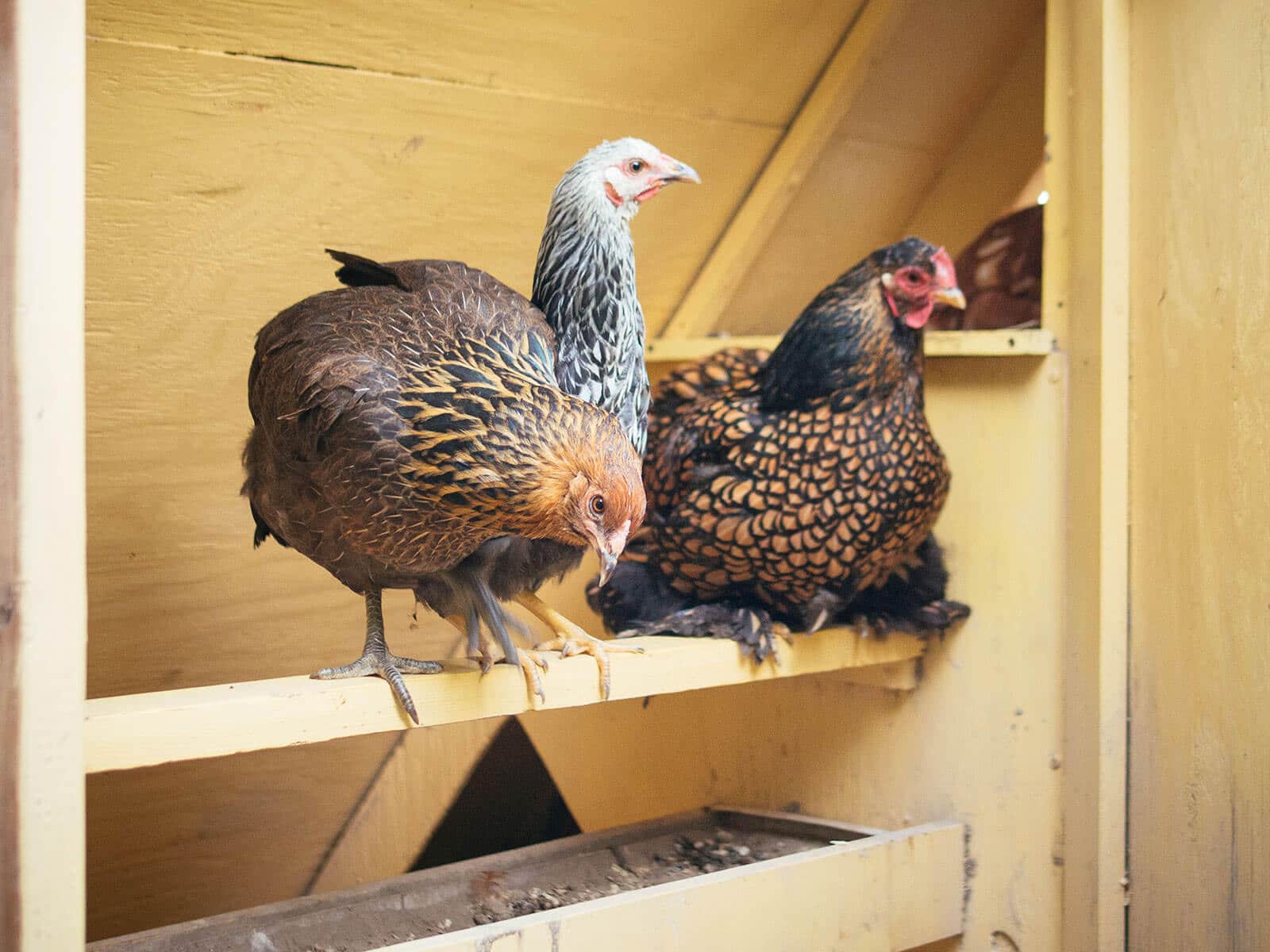
How do you find all the ingredients for homemade chicken feed?
Most of my grains are purchased from Azure Standard. As a natural food co-op that delivers nationwide, Azure Standard carries bulk bags of hard-to-find items like kamut and kelp, and sometimes at a better price than Amazon.
The rest of my ingredients come from local stores with a wide variety of bulk grains. (WinCo Foods was my go-to in Southern California, and still my favorite for cost, selection, and convenience. Market of Choice is my current stop in Central Oregon when I need a last-minute refill or want to try something new.)
You can find more exotic grains at places like Whole Foods Market, Sprouts Farmers Market, and in countless other natural food grocers and bulk food markets.
Your local feed store or grain mill will also carry the basics like oats, wheat, millet, and corn.
Oyster shells and grit are common ingredients found at any feed store or farm/livestock/poultry supplier.
How do you store all the whole grain ingredients?
Whole grains store for a very long time in cool and dark locations. Unless you go through a lot of feed quickly, I wouldn’t suggest keeping the grains in their original bags once opened, because weevils and rodents will think they’ve scored a buffet.
If you have a lot of space or a lot of chickens, you can dump all your ingredients into a clean metal trash can with a lid or a large galvanized steel bucket with a lid, mix them all up, and scoop out from there.
If you lack adequate space or keep a small flock, like I do, you can store the ingredients in airtight bins and mix as you go.
I scoop everything into a flexible bucket, give it a good mix, and pour the fresh food into the feeder. It’s like Christmas Day for the chickens… multiple times a month!
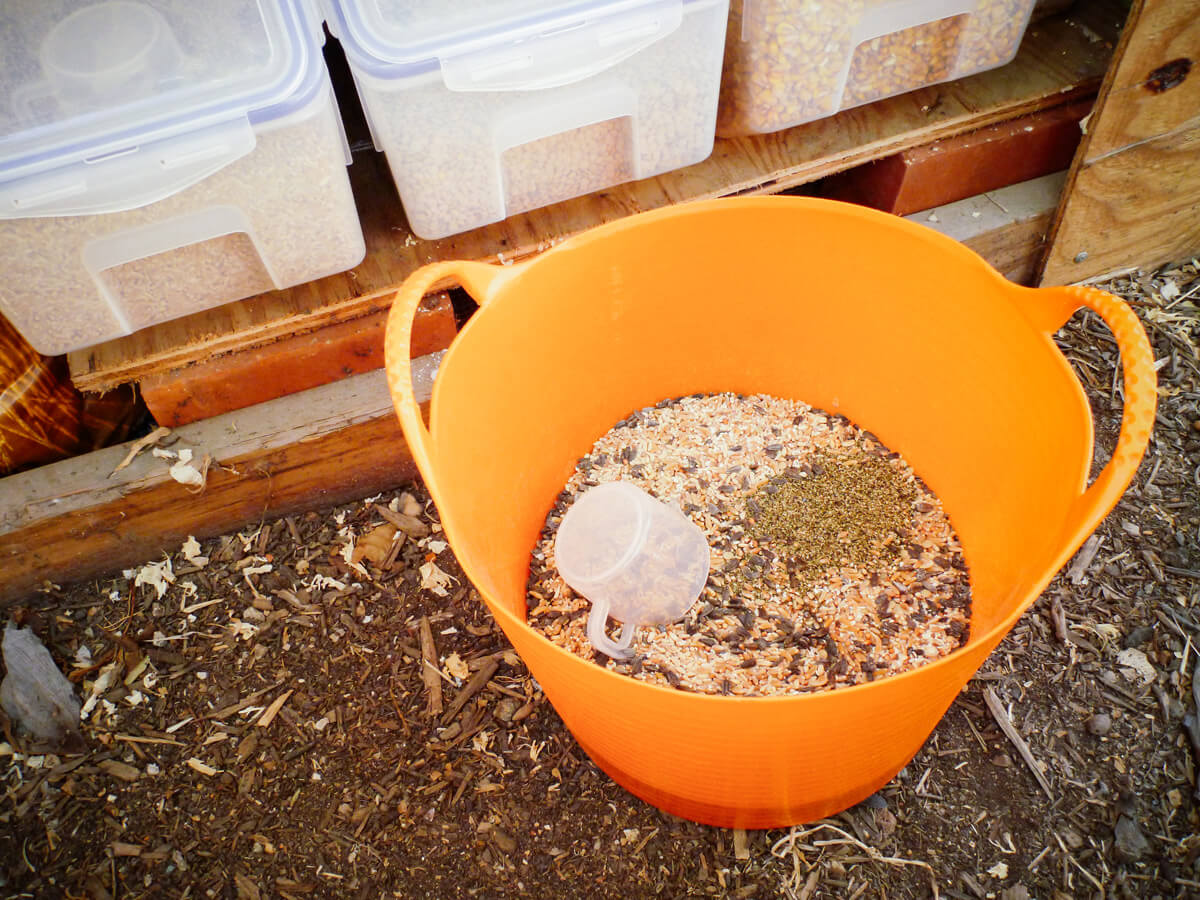
Update: Since this post was originally written, I’ve moved on to a new chicken coop that doesn’t have on-site storage, so I keep all of my grains and seeds in the garage. I’ve also added a few other containers — that I like just as much, if not more than my first containers — which are all linked in my sources at the end of this post.
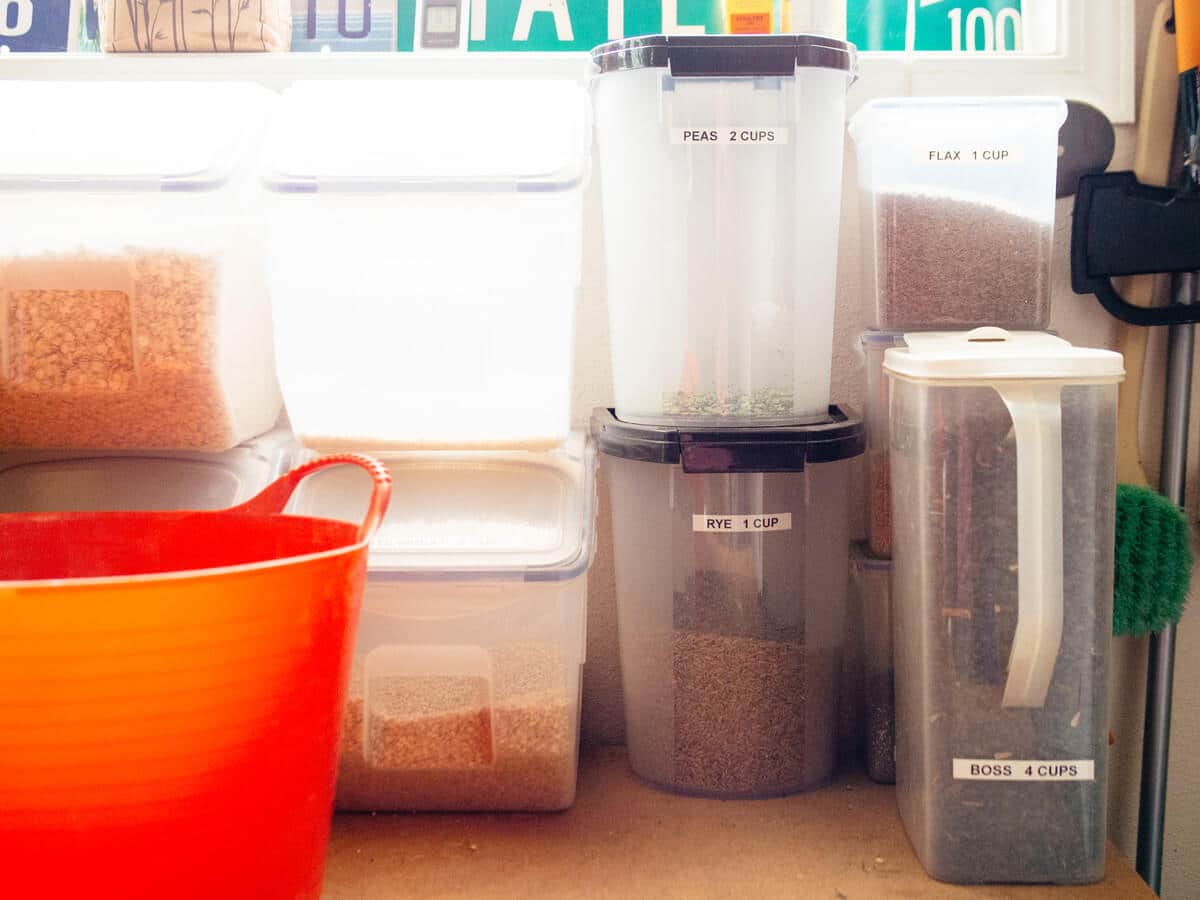
How do you switch a flock from crumbles/pellets to whole grains?
Start by gradually mixing in a little bit of whole grains into your chickens’ current feed to adapt their gizzards.
If they don’t forage frequently, make sure you offer them grit in a separate, free-choice feeder (I use this one).
Chickens don’t have teeth, so they swallow a small amount of grit and store them in their gizzards to grind up food. This is especially important for whole grains that need to be broken down.
Increase the amount of whole grains in their feed each week, until eventually you’re only feeding them whole grains. It may take a few weeks for your chickens to adjust to the change, so don’t be alarmed if egg production drops off a bit.
They may also start flinging grains all over the place (you’ll soon learn what they like and don’t like) or picking out certain grains first. (I believe chickens know what their bodies need nutritionally, so some days they may feed on more protein, less calcium, etc.)
Because of this, it’s a good idea to start with small amounts of different grains and seeds, and see what your chickens will eat before buying in bulk.

How much protein do chickens need?
My homemade chicken feed is around 17 percent protein, which is in the target range for laying hens.
This is a good number to know if you’re only feeding whole grains. But if you supplement their diet with pasture, scratch, mealworms, and kitchen scraps, all that food will increase (or decrease) the amount of protein they take in each day, so don’t get too hung up on the number.
The cool thing about making your own feed is being able to custom make it for your flock. You can make this chicken feed in bulk if you have a larger flock, just scale the recipe accordingly.
Keep reading for lots of suggestions and alternatives so you can create the best homemade chicken feed for your flock!
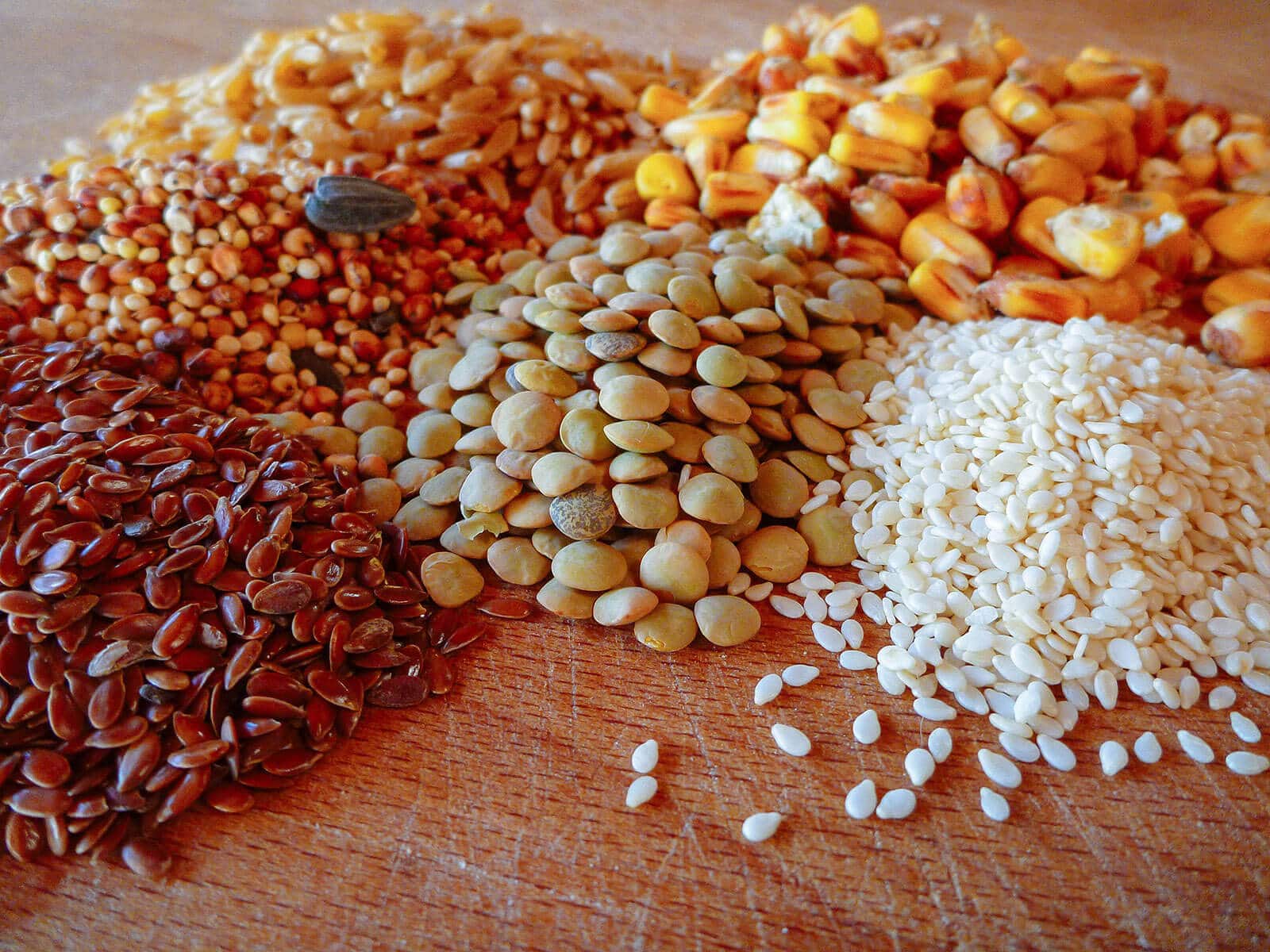
Garden Betty’s Homemade Whole Grain Chicken Feed
Makes 8 1/2 pounds (fills 10-pound feeder)
Ingredients
4 cups oat groats
4 cups black oil sunflower seeds
4 cups hard red wheat berries
2 cups soft white wheat berries
2 cups kamut
2 cups millet
2 cups whole corn
1 cup lentils
1 cup sesame seeds
1 cup flax seeds
1/2 cup brewer’s yeast
1/4 cup kelp granules
Free-choice oyster shells
Free-choice grit
Oats are rich in protein (around 16 percent), B vitamins, calcium and fiber. Oats are also a good (and cheap) source of energy. All oats—no matter how they’re processed—are nutritionally similar, so you can feed oat groats, steel-cut oats, rolled oats, and quick oats interchangeably.
Black oil sunflower seeds (often called BOSS) are like candy to chickens. But good candy! BOSS is high in protein (averaging 17 percent), rich in minerals and vitamins, and the high oil content gives feathers a beautiful gloss. BOSS is typically found in the bird seed aisle at pet and feed stores, and I buy mine from a local farm and garden store. You can also substitute striped sunflower seeds (the seeds that are typically packaged as human snacks), but they tend to be larger than BOSS with thicker shells.
Wheat is a major energy source for chickens. If you can find both varieties, buy hard red wheat and soft white wheat for the best nutritional balance. Otherwise, feed only hard red wheat, as it contains more protein (around 15 percent).
Kamut is actually a brand of khorasan wheat, but these days the grain is simply known as kamut… the way kleenex is synonymous with tissue. It’s an ancient Egyptian grain that’s nutritionally superior to other wheat in terms of protein (18 percent), magnesium, zinc, and vitamin E.
Millet (unhulled) is found in most bird seed, and in fact, the millet I buy is a mix of red and white millet sold at the store as “wild bird food.” It’s less expensive than human-grade hulled millet, but still rich in amino acids and iron. Feed stores sometimes label the unhulled white millet as “proso millet” (not to be confused with spray millet, which is a long and thin seed head).
Whole corn is a fairly large kernel, so depending on your chickens, you may have to crack or grind the corn first. You can also feed popcorn kernels, which are half the size and easier for smaller breeds to pick up. Corn is low in protein, vitamins, and minerals, but it does provide energy and fat (which is especially helpful in winter).
Lentils are very high in protein (at least 26 percent) and if your chickens take to them, it’s worth adding more to your feed. Mine don’t particularly care for lentils or any legumes, for that matter, so I only add a small portion to my feed.
Sesame seeds have one of the highest amounts of protein in a seed (around 25 percent), so they’re especially good for picky chickens that won’t eat legumes. They’re also one of the more expensive ingredients in my feed, so I add them sparingly.
Flax seeds boost omega-3 fatty acids in eggs, and are also rich in protein (37 percent), B vitamins, and minerals.
Brewer’s yeast (animal grade) can be found online or at local feed stores. You can buy human-grade brewer’s yeast too, but you’ll end up paying double (at least). It’s an important source of B vitamins and protein (around 35 percent) for chickens. (On a side note, I’ve also read that feeding brewer’s yeast to your dog will repel ticks and fleas, in addition to providing all the other good stuff.)
Kelp granules (or kelp meal) are basically little bits of dried seaweed. Kelp contains essential vitamins, minerals, amino acids, and salt that your chickens need. It promotes healthy growth, increases egg production, and darkens yolk color—an overall superior supplement.
Oyster shells provide the necessary calcium to strengthen your chickens’ eggshells. Feed this free choice, and they’ll take what they need each day. You can also feed them clean, crushed eggshells to put all that calcium back into their bodies.
Grit is typically limestone or granite gravel that aids the gizzard in grinding food. If your chickens free range, they’ll probably pick up little stones on their own and won’t take as much from the free-choice grit.
Other good sources of protein include triticale, field peas, and split peas (or any peas in general — many soy-free commercial feeds rely on peas to provide sufficient protein).
If money is no object, you could also add quinoa, spelt, wild rice, amaranth seeds, nyjer seeds, hemp seeds, or shelled peanuts as excellent protein sources.
Feeding lower-protein grains like rye, barley, buckwheat, and sorghum (milo) in small amounts will balance the higher-protein (and usually higher-cost) grains.
Try not to make your feed too heavy on any particular grain. The University of Kentucky College of Agriculture offers good information on the pros and cons of common feed grains on their Poultry Extension site.
At the end of the day, if you feed a balanced meal of grains, greens and garden pests—with a little treat here and there—numbers are not as important as a diverse diet.
Where to buy chicken feed supplies
[show_shopthepost_widget id=”3116483″]
Lock & Lock Bulk Storage Bin | Lock & Lock Square Tall Food Storage Container | Buddeez Plastic Storage Container for Pet Food | Iris Nesting Airtight Pet Food Container | Tubtrugs Storage Bucket | Miller Baby Fig Feeder | Little Giant Galvanized Hanging Feeder | AniMed Pure Brewers Yeast | Starwest Botanicals Organic Kelp Granules | Scratch and Peck Feeds Oyster Shell | Scratch and Peck Feeds Grower Grit
Homemade Corn-Free Soy-Free Chicken Feed With Whole Grains
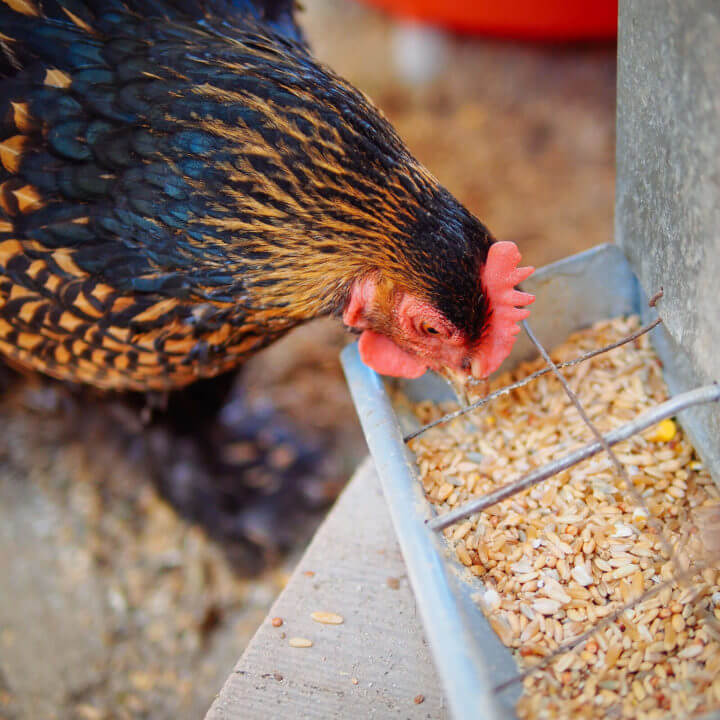
Garden Betty's homemade whole grain chicken feed just got better. This new recipe is corn-free (as well as soy-free) and makes the perfect feed for your favorite layers.
Ingredients
- 4 cups oat groats
- 4 cups black oil sunflower seeds
- 4 cups hard red wheat berries
- 2 cups soft white wheat berries
- 2 cups triticale berries
- 2 cups rye berries
- 2 cups millet
- 2 cups sesame seeds
- 1 cup flax seeds
- 1/2 cup brewer’s yeast
- 1/4 cup kelp granules
- Free-choice oyster shells (or crushed eggshells)
- Free-choice grit
Instructions
- Combine all of the ingredients, except the oyster shells and grit, in a small bucket.
- Fill your feeder with the mixed-grain feed, or store the feed in a pet food container or a galvanized steel bucket with a lid.
- Offer the oyster shells and grit in separate small feeders for your chickens to eat as they wish.
This post updated from an article that originally appeared on June 29, 2012.
View the Web Story on homemade whole-grain chicken feed recipe.


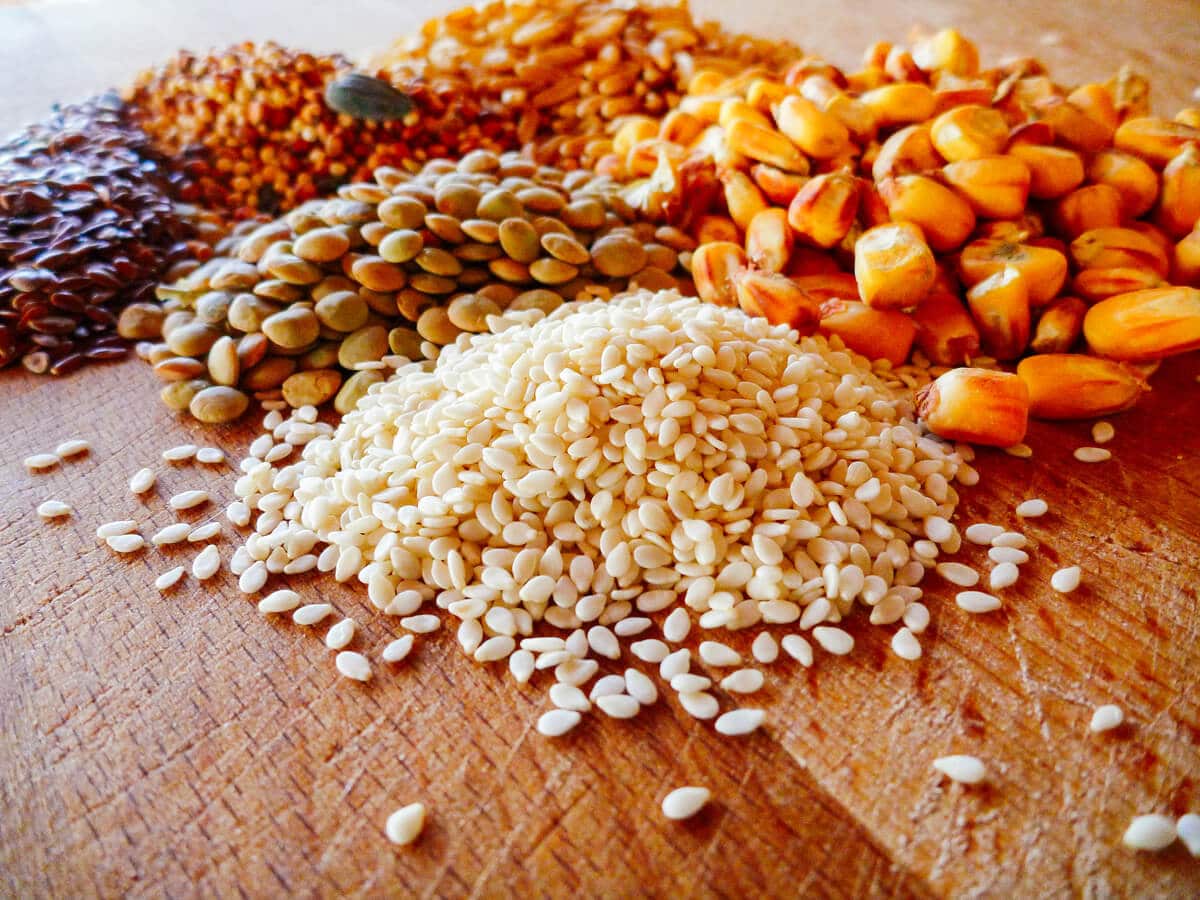

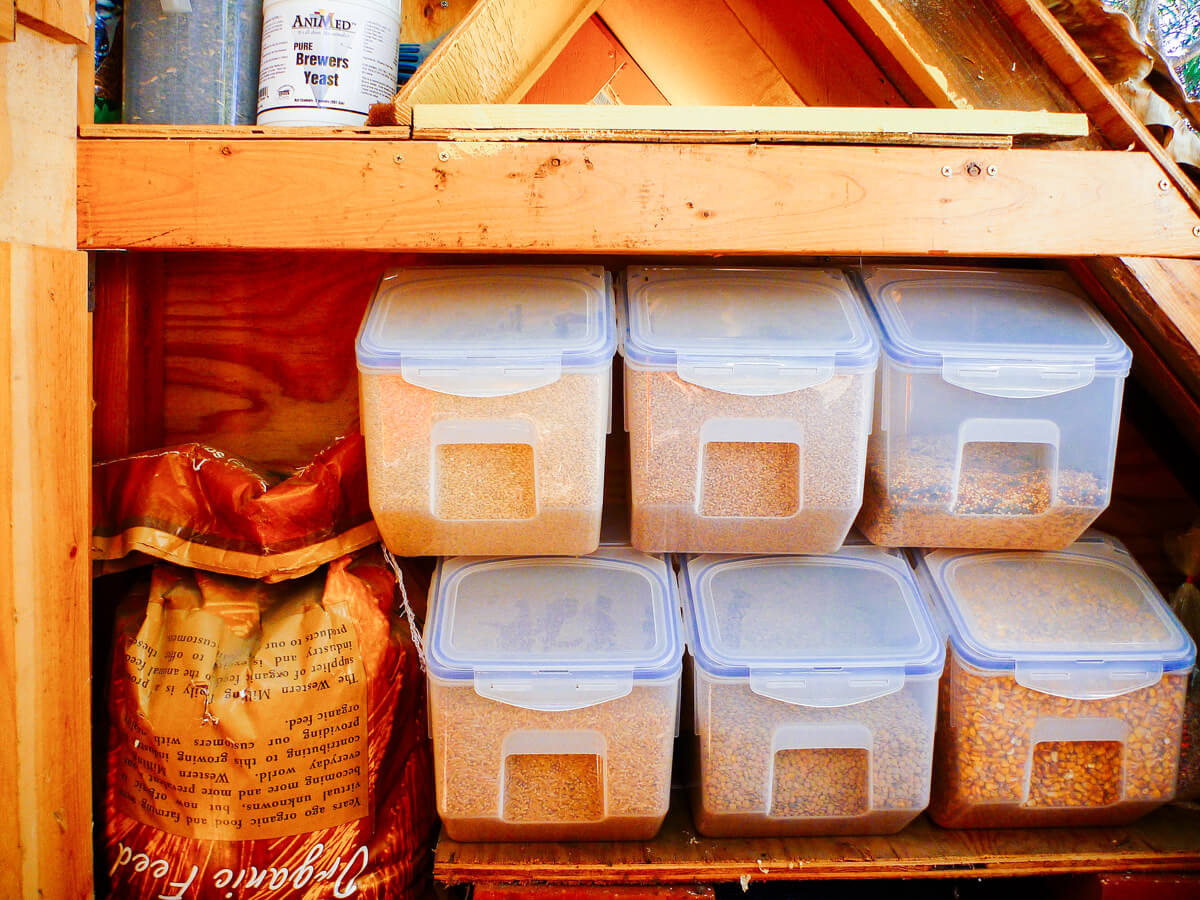
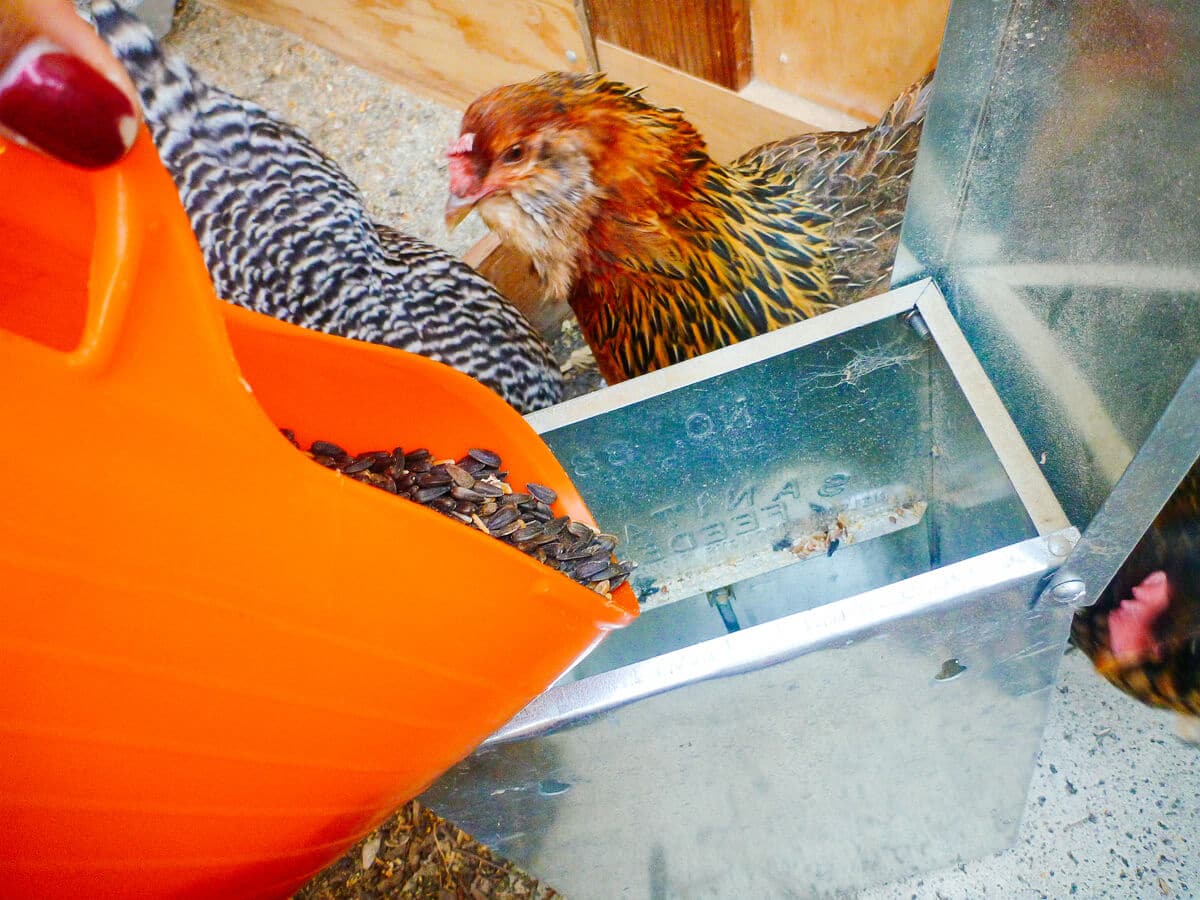













Hello! I are you familiar with fodder ? I’m considering growing fodder. I know I can’t just feed them barely, but if I grew a combination of different seeds, I would this be enough for a balanced diet ?
Fodder by itself won’t supply all the nutrients that chickens need. However, if your flock also free-ranges, and your pasture is varied (green year-round) with lots of bugs and other protein sources, it’s a decent source of feed — just know that your chickens might not lay to their full potential. You also have to make sure to provide calcium free-choice.
I feel fodder is best as a supplement, especially in winter when weeds and other greens are scarce.
I am new to keeping backyard chickens. We have 5 pullets that are between 8-10 weeks old. I would start to make my own feed for them Do you think I can use this recipe for them?
They are in the run during the day and free range only when we are around.
Absolutely! You can use my chicken feed calculator to determine the right amount of protein for your pullets: https://gardenbetty.com/garden-bettys-chicken-feed-calculator-for-determining-your-protein-content/
Just omit the free-choice oyster shells for now, and introduce the oyster shells once your chickens start laying.
Thank you! They are on the grower feed right now but I feel miserable feeding them that. Thanks for painstaking creating the spreadsheet. It is very hepful!
What can I substitute for the Kamut? I cannot find it at an affordable price
You can use another high-protein grain or seed in its place.
Would this mix be ok for fermenting?
Yes, it’s the exact feed I ferment! My fermenting instructions are here: https://gardenbetty.com/why-and-how-to-ferment-your-chicken-feed/
I have downloaded your chicken feed calculator, but can’t seem to be able to edit it. Dropbox wants me to ask your for access. I have done this but haven’t heard anything. Can you help?
Hi, you have to download the spreadsheet to your own hard drive first before you can edit it.
Hi! I’m looking forward to trying your recipe. As I shop for ingredients, I noticed that hard red wheat berries come in two varieties – Winter and Spring? Does it matter which type I use?
Hard red spring wheat typically has higher protein content than winter wheat — check the labels to be sure.
I did a quick word search on “fat” to check if this had been addressed already and didn’t see anything, so apologies if this is a repeat question.
Can you give me an idea of what percentage fat in the total recipe I should aim for (using your calculator)? And what numbers you specifically like to see when you up it during molting season (and winter if you’re in Maine like I am)?
Thanks so much, and thanks for all the work you put into this! I’ve been feeding my eight layers organic layer feed since the beginning, but I always liked to throw them wild bird seed as a treat mixed with some corn and mealworms, and over the past few years have realized it’s more cost efficient to buy most of the seeds individually in larger quantities, which opened up my world to getting to include a little bit of everything that was available in bulk! After stumbling upon your recipe, it dawned on my that I’m more than halfway to my own recipe, so I’m seeking out the holes I haven’t been filling now! Thank you again for being a fellow dedicated chicken lover. <3
Christine
Hi Christine, I’m glad you’ve decided to make your own feed! You’ll probably find this very easy since you’ve been working with some of these ingredients already.
As for fat, I generally stay at or under 10% for my chicken feed. This is actually more than the fat content you’ll find in commercial feed, but I’ve never had a fat chicken; in fact, my avian vet says our chickens are on the slimmer side compared to what she’s seen. I think it’s because we let our chickens free-range and give them lots of greens and kitchen scraps in addition to their feed, so their diet doesn’t depend entirely on grain. It’s something you’ll have to keep an eye on and see what works for your flock.
During molting season and in winter, I’ll throw out more scratch in the form of BOSS and corn for added fat.
I have always used your recipe and all of my birds lay in the winter, even in sub-zero temperatures. I didn’t even think about it being the feed recipe until I received your recent email. Thank you!
You’re very welcome!
I was wondering about chicks. I’ve been using your post as a guideline but I’m scared these grains are too large for our new chicks. They hatched last night. Thoughts and suggestions on this?
You can coarsely grind the larger grains and seeds in a food processor; just try not to make it too powdery. Be sure to provide chick grit (free choice) as well.
Hello, I tried replying a couple days ago but I guess it didn’t work or something. I have been feeding this recipe to my chicken for about a month or two, they absolutely love it… every last drop. Unfortunately I am getting no eggs. I normally get about 8 eggs a day if I were to average it out. it goes anywhere between 8 and 12 a day. but ever since I have stated this diet I get on average 2 eggs a day. sometimes its 3 and sometimes its 0, please help me. I am ready to go back to store bought food and I don’t want to.
If you’ve recently changed their food, it’s normal for egg production to drop a bit as their bodies adjust to the new diet. But since we’re moving into shorter days now, you’re probably seeing a prolonged period of fewer eggs that’s typical in fall/winter. They should start laying normally again by early spring. I’d also check to see if they’re maybe hiding eggs… mine do that on occasion.
I’ve read a bit about brewer’s vs nutritional yeast. Did you try both? Why brewer’s over nutritional in your recipe?
I’ve only used brewer’s yeast because you can get it in animal grade, which makes it more cost-effective.
Hi, what can I sub for the wheat and oats. I’m celiac so I can’t have those in my home or work with them. Would buckwheat work or quinoa? My daughter has to feed the chickens after I found that I was reacting to the commercial feed. Thanks.
Yes, you can try buckwheat, quinoa, amaranth, teff, brown rice, wild rice, hemp seeds, or pumpkin seeds. Download my chicken feed calculator to make sure you’re providing enough protein for your flock: https://gardenbetty.com/garden-bettys-chicken-feed-calculator-for-determining-your-protein-content/
Is the only thing that matters when mixing and matching protein content? How do you make sure that they get enough amino acids and vitamin? Thank you for sharing your recipe
I love the grain recipe! I’ve been using it for over 6 months. I am still feeding my 15 chickens (I must stop there!) regular organic chick feed, but I make the grain recipe and I ferment it for even greater/easier absorption. They go nuts for it! I give them a total of about two cups 4 times a week. The other days I give other treats like scrambled eggs (Their other favorite food.), grapes, kelp and swiss chard leaves from my garden. Great site Linda!
Thank you! Your chickens are very lucky, spoiled girls! 😉
Colby, I would love to know your process for fermenting the whole grains recipe ! Judith
Hi Judy, you can refer to my fermenting process here: https://gardenbetty.com/why-and-how-to-ferment-your-chicken-feed/
Thank you!
Linda
According to Azure Standard: the Rye has 4g protein in 1/4cup, MILO has 21.7g protein in 1 cup, Millet has 11g in 1/2 cup, Oat Bran has 16.3g in 1 cup, Wheat Bran has 9g protein in 1cup, Oat Groats has 7g protein in 1/4 cup .
I don’t know where you got that milo is low in protein.
Milo averages 9% to 10% in crude protein value. This is low in comparison to other grains like triticale and quinoa.
So bummed. I decided to feed my chickens Betty’s hommade recipe for feed. Ordered everything, and when I got to checkout, the shipping cost was 1/2 as much as my order. I still had to order from two other sites. I had to abandon making my own, because scraping up over $300 for 75% of my order was unaffordable and disappointing. Sigh.
Oh, that’s a bummer. I’ve found that the best sources for bulk grains like these is Azure Standard (as long as you have a drop point nearby), a local feed store or feed mill where you can buy them in person, or a local market that carries bulk grains and seeds. These are heavy items, so they’re usually not very economical when ordering online unless you can get free shipping.
I am glad I found your website. It confirms what I have been thinking lately about feeding chickens. Crumble and pellets must be like cardboard to the chickens! They waste most of what comes out of the ‘scratch’ and cracked grain bags I buy so I try to watch and see what they like, and work in the nutrition. The chickens have been eating bird see lately for the millet and sunflower seeds but I will have to watch that because of all the fat in sunflower seeds. And I have been giving them too much dried meal worms. It has just turned to fall here in Missouri and the poor free range chickens are wondering where all the bugs went!! They still like to go in the cow pasture and scratch so they must be finding something to eat…like corn since we have cows. Sometimes I give my chickens some vitamin/mineral supplement that I drink myself and I put it in their water, but scale down the amount for their size. It is a product by a man who used to be a vet at St. Louis Zoo-MO. He treated animals with nutrition and wondered why we didn’t treat and heal ourselves the same way. He went on the get degree in biochemistry, I think, and has a supplement line. Sorry this isn’t meant to be an ‘ad’ for him….the point is how important nutrition is. When we consider that chickens that came west with the pioneers didn’t have crumble and pellets you have to ask ‘What did they eat!” Real Food!! And bugs! and probably some corn, seeds off the grass, etc. Natural stuff.
Free-ranging chickens are the happiest chickens for sure! And if we can try to replicate what they’d eat if they were left to forage on their own, we all benefit.
I love your post, it was just what I was looking for….I am want to raise Gluten Free chickens/eggs (we do not plan on eating the chickens)….By feeding the chickens grains like wheat will it then make the eggs yolk and egg tissue glutenous.( If the soy affects the egg tissue, will the wheat grains also do the same? Would feeding them the alternative grains like raw hempseed which a complete high quality protein work as well? You listed it to be use to balancer protein, not a main source is why I ask. I am in the research phase and understanding the chickens needs too as well as my families.
I cannot say whether the wheat you feed your chickens would transfer to the eggs in any amount that may adversely affect your health. I suppose it depends on whether you’ve had reactions after eating store-bought eggs? But if you’re making your own feed, I recommend giving your flock a wide variety of grains and seeds (and possibly a supplement, like Fertrell’s Nutri-Balancer) to ensure they have all the nutrients they need.
Hello, I have a random question. Where did you get your feeder?! I’m looking for something exactly like this, I’d be very interested to know. Thanks!
I use this one: http://amzn.to/2v8JpAQ
Very empowering ! I’ve been flip[ing out trying to figure what to feed my new little sisters and now I know , Food !
Hi Linda, thanks for the recipe, I’ve been looking for a corn-free chicken feed recipe for my chooks, great article and very informative…
Thank you for the recipe. I was so excited to try and bought all ingredients in small amount at Whole Foods. TThiught the girls would love. Unfortunately they are barely touching it. They free range all day but when they see us they run to us to feed them. I switched about a week or so ago to just boss and cracked corn when layer feed finished. Now wondering if I should go back to a later feed but would rather not. What are your thoughts?
Thank you
When changing your flock’s diet, it should be introduced gradually. I suggest mixing some of the new grains with their old feed, increasing the amount of new grains each week until they are only eating those grains. If the chickens are especially stubborn, you might want to keep them inside an enclosed run for a couple of days so they’ll have no choice but to eat the grains.
Hi Linda! I have recently discovered I am allergic to corn(one of my favorite foods) and most of the poultry feeds on the market that I have access to are pretty pricey for a single income household and are so far away from us that the freight costs are insane, although I find the products to be awesome. Is there something that I may substitute in this recipe for the corn, or can I increase some of the other ingredients while not interfering with the nutritional content too much? I like that 17% protein target you hit. I think it is perfect considering I also have 2 roosters in my flock.
I am a member with Azure and I love it. Recently they were out of stock on the feed that I was going to switch back to, and it looks like I will be delayed a bit. Which now buys me some time to weigh options.
haha! disregard that! I just saw the update! I cannot wait for my new eyeglasses to arrive. I swear I didn’t even see that yesterday. 😮
You can take a look at this follow-up post where I omitted the corn in my own feed: http://gardenbetty.com/2013/04/homemade-whole-grain-chicken-feed-updated-and-now-corn-free/
And if you want more ingredient substitutions, do read the comments on both of these posts, and perhaps try my chicken feed calculator for more options if you want to make your own feed: http://gardenbetty.com/2014/11/garden-bettys-chicken-feed-calculator-for-determining-your-protein-content/
Good luck!
Hello Linda.
A lot of thanks for you calculator. I just bought whole grains and it helped me a lot to mix my own. Thank you so much!
I translated it and converted it into metric data, so it’s easier to work with. I would like to share with Slovenian chicken community, if you don’t mind? Lots of people don’t know English and translated calculator will help them a lot. I will give them the link to your website and give you all the credits for making the calculator!
A question though. Where did you get the data for crude fat content for your ingredients? For example, Oats have
6.9% crude fat in your calculator? Probably you are referring to oat groats or naked oats? It’s really hard to get the data for whole
unhulled oats, which are mostly available and used as feed in our
country. They have a lot of fibers and I’m sure the numbers are quite different. In most cases data on web says unhulled oats are low in energy which is not the case in your article and in calculator.
Thank you!
The crude fat content is mostly pulled from the nutrition data label on my own ingredients, as well as general data online (from US sources), so there will be some variation among manufacturers. If that’s something you want to keep an eye on, I suggest using your own figures for accuracy, rather than mine. Best of luck, I’m glad it’s helping you and your community in Slovenia!
Sure, that is a real self sufficient tip. We could include some sushi and shiitake mushrooms and why not some french truffles.
To all those that have not been brain damaged by retards advising on blogs, here is what you need to feed chicken or laying hens:
80% cereal (corn, wheat, sorghum, barley) any you can get a hold on.
20 % soaked for 24 hrs and boiled soybean, or raw peas beans or any legume that you can have around, alfalfa would be like caviar to them. Table spoon of salt, table spoon of limestone or any other calcium carbonate source per 25 kg.
It pisses me of this city morons or pseudo hippies that think they can give advice to those that are really fighting to be independent.
Love to all that think they can make it on their own….
Surely you can contribute a helpful comment without resorting to name-calling. Your “recipe” works as well, and is very similar to the one suggested in this post. I don’t really see how one is more “pseudo hippie” than the other as they both contain cereal, legumes, salt, and calcium.
What are the benefits of using a homemade recipe such as the above over using an all organic and GMO free premix like Scratch and Peck’s feed lines? For me the total cost on either is about the same however using Scratch and Peck gives the advantage of using an all organic product where as the homemade feed wouldn’t be.
I’m a bit torn on which to use!
I considered buying Scratch and Peck in the beginning, but ultimately decided to mix my own so I could include a greater variety of grains and seeds. If you read their nutrition label, you’ll see that their feeds rely on a vitamin and mineral premix (all the ingredients after sesame meal) to create a complete feed. There’s nothing wrong with that, but I prefer a custom feed that I can tailor to my chickens based on their needs. For example, in the fall I increase their protein a bit while they’re molting to help with feather growth. I also swap out ingredients once in a while if I see them start to prefer some over others (with a whole grain feed like this, it’s easy for chickens to pick out what they like or don’t like – and that includes the ingredients in Scratch and Peck feed). You might not be able to find everything organic for your custom feed, but I feel the benefits outweigh that fact. (If you live near a grain/feed mill, you might have better luck sourcing ingredients. Sometimes grains aren’t certified organic but are still raised according to organic principles.)
Linda thank you! I appreciate the perspective and insight. I did notice that Scratch and Peck relied on vitamin and mineral supplements which I was disappointed about. At this point I’m either considering adding ingredients to Scratch and Peck or mixing/creating the entire feed like yourself. I do like the idea of having a variety for the ladies.
Have you thought about fermenting your chicken feed? It makes the nutrients in the food more bio available, and the chickens don’t scratch through it, so none is wasted. And it’s really good for the gut health of your chucks!
I already do ferment my chicken feed using Garden Betty’s
recipe. It works great! 🙂
Yes, this is why I looked for a recipe for whole grain feed. I would only ferment what they would eat in a day. Thanks to all
Here is the link for anyone wishing to ferment their feed: http://gardenbetty.com/2013/05/why-and-how-to-ferment-your-chicken-feed/
Great article. I am going to be purchasing some of these items (i have some already on hand that I feed my chickie babies) but I verified my email but am not able to get the download. Help please
Hi Sheri, I checked your email and it appears you did receive and click on the download, so I’m going to mark this message as resolved. Please let me know if you have any other issues.
Please help me with a recipe for baby chick feed. Thank You
If you scroll through all the comments in this thread, you’ll find lots of ideas for formulating a feed for baby chicks. I also recommend downloading my chicken feed calculator at http://gardenbetty.com/2014/11/garden-bettys-chicken-feed-calculator-for-determining-your-protein-content/ to help you create a custom chick feed with 20-22% protein.
If I just added one item to my chickens diet what would give me the most bang for my buck? My chickens used to be free range but we have a puppy and until she is big enough to leave the chickens alone, they have a run that is about 12×25 feet. My boys also work at a custom meat shop where I could probably get free livers. Would that be a good thing to give them a couple times a week?
I’m assuming you already give them commercial bagged feed, and just want to supplement with something fresher? Since they’re already getting all the protein they need from the bagged feed, I’d say leafy greens are your best bet. You could give them liver as an occasional treat, but be sure to feed it in a dish and remove the dish each day when they’re done, so as not to attract unwanted critters at night.
Thanks, Yes I meant to supplement the bagged feed. We have long winters in Montana, so hard to get greens. We had to resort to a feeder that opens when they step on it because of the unwanted critters…..
If you have access to alfalfa, that’s highly nutritious for your chickens as well!
Do you use hulled or unhulled sesame seeds in the chicken recipe?
Thank you.
You can use either; chickens do not need any of their seeds or grains hulled before eating them. I go with whatever’s cheapest at the time I buy it!
how much do you feed them? It just says to “I scoop everything into a flexible bucket give it a good mix, and pour the fresh food into the feeder.”
I leave the grains out for my chickens (to self-feed) and refill as needed. With the size of my flock and the size of their feeder, I usually refill every 2 weeks.
I love your recipe and have purchased all my grains through azure standard. How much of this feed do you give per chicken each day? And I saw in the posts that you suggested Fertrell’s Nutri-Balancer….my chickens roam the pasture but I wondered if I used that balancer do you think it could replace the brewers yeast and the kelp in your recipe? It seems like it might cost less to do that?
Thank you!
I fill a feeder and let my chickens eat as much as they want. They also roam a pasture, so it’s hard to say how much to feed your chickens since it depends on what they eat throughout the day. I only recommend Fertrell if people aren’t able to source a wide variety of grains, as the supplement can fill in the remaining nutrients that may be missing from a more limited grain-based diet. It’s also a good idea for chickens that don’t get to graze on grasses, weeds, bugs, etc. You can add it to your feed if you can’t find some of the other ingredients, but it’s not necessary otherwise.
Is the fertrells a powder? Would it just sink to the bottom? Thank you!
How about some links to where I can get the kelp granules? I’d love to try making feed for my chickens. 🙂
I have been searching for 2 days for a whole grain recipe for replacing turkey grower for turkeys and this is the closest I have gotten. Do you know where there is one or convert this recipe for turkeys?
Can I feed this to my baby chicks?
Yes, but you would need to increase the protein content and substitute some of the larger grains for smaller ones. Read through the whole comment thread on this post and you’ll find lots of ideas and suggestions for adapting this feed to baby chicks.
Any advice on what to use instead of sesame seeds? They are just so expensive.
Hi, thanks for sharing your information. I love your site and have been using your whole grain diet for my hens for quite some time now. They are very healthy. Do you have any thoughts or recommendations on adding greens? I do give them our veggie scraps but I have a small household so we don’t generate a much. I also don’t let them free range very often because of predators. I give them alfalfa but am wondering if you have any suggestions as I would like to add more greens to their diet.
I give them greens every day and I do believe they’re an essential part of a healthful diet. If you don’t have enough in your garden to share, you could make friends with some of the vendors at your local farmers’ markets and ask to buy their leftover produce at the end of the day (usually at a deep discount). I also let my flock “clean up” my garden beds at the end of each season, they go wild for all the plants that are bug-ridden and starting to seed. They also LOVE weeds! So this spring, I’ve been putting them to work in the yard. 😉
I like that you are concerned with the overly modified soy and corn. I also share that concern and add wheat to that list due to the fact it is not the same wheat that we had 60 years ago. My question is what would you recommend for an alternative to wheat?
You can try an heirloom wheat (if your concern is not allergy-related), an ancient wheat like kamut, or one of the ancient grains like emmer, einkorn, or spelt (collectively called farro). I list many other available ingredients in my chicken feed spreadsheet here: http://gardenbetty.com/2014/11/garden-bettys-chicken-feed-calculator-for-determining-your-protein-content/ .
Just wondering, can this mix be fermented?
Yep! Just leave out the brewer’s yeast: http://gardenbetty.com/2013/05/why-and-how-to-ferment-your-chicken-feed/
I saw you had an excell spreaad sheet but I can’t seem to dodwnload it…I’m on my work computer I have no home one Could you e-mail it to me swetterbeg1955@yahoo.com I just need to start feeding htem a better diet I want those gold yello yoks.. I buy all my feed either from Qc supply or TC Help is so thankful
All the instructions for requesting and downloading my chicken feed calculator are in that post. Please read through it: http://gardenbetty.com/2014/11/garden-bettys-chicken-feed-calculator-for-determining-your-protein-content/
Ok…I need to do this with my chciken Where do I start
I’m not sure what you are asking here. All the information you need is in this post. Please read through it, as well as the comment thread which has lots of advice for a variety of situations.